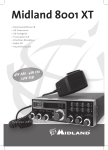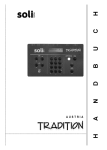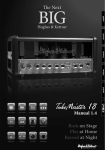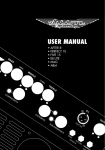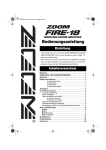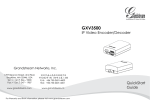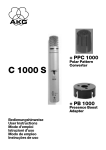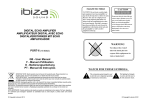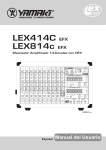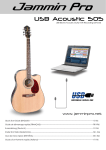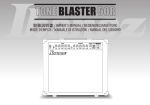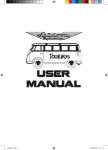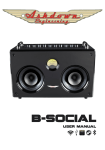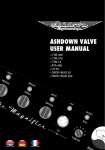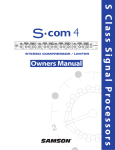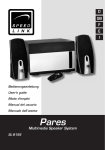Download Specifica tion S
Transcript
www.ashdownmusic.com 1 USER MANUAL WELCOME Thank you Thank you for purchasing your Ashdown Engineering Amplifier and welcome to the family! We really think you’ve made the right choice and know that this amplifier will give you years of great tone and service. It is a machine though and needs to be looked after, please read through this user manual which will help you get the most out of your new Amp and keep it running as long as some of our happiest and very famous customers. REGISTER ONLINE Please register this product online so we can make sure we give you years of customer support through our friendly in-house service centre. Here is where you need to visit to register your product: http://www.ashdownmusic.com/register www.ashdownmusic.com 2 www.ashdownmusic.com www.ashdownmusic.com 3 USER MANUAL AAA AFTER 8 Front Panel hIGh INPUT LoW INPUT BASS 46 3 CLIP APPTEk MIDDLE 46 7 7 3 TREBLE 46 7 3 AUX MIX 46 7 3 VoLUME 46 7 3 2 8 2 8 2 8 2 8 2 8 2 1 9 1 9 1 9 1 9 1 9 1 0 10 0 10 0 10 0 10 0 FRONT PANEL LINE IN APPTEK This enables you to further expand your amp for use with the provided cable and your Agile Partners Amp Kit App. The App features the Ashdown ABM 900 and ABM 810 cab which can be used with your amp utilizing the features of the ABM including SUB Harmonics, Valve Drive, Compression and EQ. 46 10 3 7 0 10 8 9 AFTER 8 Headphones A headphone jack socket is provided to allow stereo headphones to be plugged into the amplifier for silent practice. This cuts out the main speaker when a jack plug is inserted. PERFECT 10 Front Panel hIGh INPUT LoW INPUT 46 APPTEk 46 7 3 CLIP BASS DRIVE 3 MIDDLE 46 3 7 TREBLE 46 3 7 AUX MIX 46 3 7 VoLUME 46 3 7 46 7 2 8 2 8 2 8 2 8 2 8 2 8 2 1 9 1 9 1 9 1 9 1 9 1 9 1 0 10 0 10 0 10 0 10 0 10 0 LINE IN A single balanced line input is provided for play along practice. Used in conjunction with the Headphones socket for silent practice. Also see, MIX. LINE IN 10 3 7 0 10 8 AUX MIX Set the level of your Backing Track by using the ‘MIX’ Rotary control provided. 9 PERFECT 10 DI MASTER level Use the output level control to adjust the playing volume of the amplifier. E.Q. This passive EQ has bass, middle and treble tone controls. VINTAGE 12 Front Panel hIGh INPUT LoW INPUT BASS DRIVE MIDDLE TREBLE AUX MIX VoLUME LINE IN DI (were applicable) DI Output provides a balanced post signal output. Drive in/out 46 CLIP APPTEk 46 7 3 2 1 0 3 8 2 9 1 10 46 3 7 0 8 2 9 1 10 46 0 46 3 7 8 2 9 1 10 3 7 0 8 2 9 1 10 46 3 7 0 8 2 9 1 10 46 3 7 0 8 2 9 1 10 7 8 9 0 Drive (were applicable) This adds tube emulated overdrive as a tube amp would when adding gain. From slight grit to full on overdrive. 10 VINTAGE 12 DI Input Two input jack socket are provided for your instrument. There is a high impedance input designed to have sufficient headroom available to allow active basses to be used. There is also a low impedance input perfectly match the impedance of the pick-ups on a passive bass. Use the input gain control to adjust for the sensitivity of your instrument. FIVE 15 & FIVE 15 BB Front Panel INPUT hIGh LoW INPUT BASS DRIVE MIDDLE TREBLE AUX MIX VoLUME FX LooP LINE IN DI Drive in/out APPTEk 46 46 3 7 0 10 2 1 8 2 9 1 3 7 0 10 8 2 9 1 46 3 7 0 10 8 2 9 1 46 3 7 0 10 8 2 9 1 46 46 3 7 0 10 8 2 9 1 3 7 0 10 8 2 9 1 3 7 0 10 8 9 SEND RETURN FIVE 15 Back Panel Rear panel Fused mains inlet socket This is for connection of the unit to your countries mains power supply. Please ensure that the type and rating of mains fuse marked on the rear panel is used when this is replaced. Power switch The power to the unit is turned on with the rear panel power switch. A power led on the front panel will light to indicate that the amplifier is switched on. FIVE 15 BB after 8 Output Power Input Impedance Input Signal Range E.Q. 20watts rms into 8 ohms 1 Meg ohm 100Mv to 10v Passive Bass, Middle, Treble. VINTAGE 12 Output Power Input Impedance Input Signal Range E.Q. 20watts rms into 8 ohms 1 Meg ohm 100Mv to 10v Passive Bass, Middle, Treble. Perfect 10 Output Power Input Impedance Input Signal Range E.Q. 40watts rms into 8 ohms 1 Meg ohm 100Mv to 10v Passive Bass, Middle, Treble. FIVE 15 & BB Output Power Input Impedance Input Signal Range E.Q. 100(220BB)watts rms 8 ohms 1 Meg ohm 100Mv to 10v Passive Bass, Middle, Treble. Specifications 46 CLIP SPEAKER OUT There is a speaker out fitted to the After 8, Vintage 12 and Five 15 BB with an 8Ohm min load. Ashdown Amplifiers reserve the right to change specifications without notice. E & O E. All contents © Ashdown 2014. 4 www.ashdownmusic.com www.ashdownmusic.com 5 USER MANUAL MAG ROOTMASTER Direct inject ( d.I. ) A balanced d.I. Is provided on the front panel xlr socket. This provides a post E.Q. Post effects signal. The output signal from this xlr socket is set to a level and impedance suitable for connecting directly into a balanced microphone input of a mixing desk for either direct injection into the pa system or for recording. Front Panel Effects send/return A serial effects loop is provided at a level of 0db. The effects send and return sockets for this are on the front panel below the d.I. Socket. The effects send socket can also be used as a line out socket if required. The signal path through the preamp is only broken when a jack plug is inserted into the effects return socket. The effects send is situated after the E.Q. Tuner/line out This output socket provides a line level signal that can be used either for a permanent connection to a tuner or a line output for connection to other power amplifiers and speakers. VU Output level The output control adjusts the overall level of the amplifier. Adjust this for your preferred overall stage playing volume. Input control The input control sets the signal level through the preamp in conjunction with the input level vu meter. This is adjusted to give a reading of 0vu on the meter for average playing dynamics with occasional peaks into the red region. Please note that the setting of this may have to be re-adjusted after modification of the E.Q. controls. Shape With this button in a fixed E.Q. is superimposed on the pre-amp to give a bass and treble boost to the sound. This gives +8db at 50hz and This gives +10db at 10khz. E.Q. This button switches the equalisation section in or out i.e. the Bass, Middle and Treble controls and the two rotary controls placed between these. Equalisation This consists of bass, middle and treble controls with two more rotary controls placed in-between. This can be used in a number of ways: Firstly as a very simple bass, middle and treble tone control section as found on older traditional amplifiers. This is done by leaving the 340hz and 1.6Khz controls set in their centre positions and using only the bass, middle and treble controls to alter the overall tone. Secondly, if more control is required then the 340hz and 1.6Khz controls can also be used to tailor the E.Q. In the regions between the main tone controls. This provides a very versatile equalisation section, it is simple to understand and operate, yet provides a wide degree of variation. It retains the simplicity of a three control tone section but provides the flexibility of a graphic equaliser. Compression Adding a small amount of compression gives a fat bottom end to the sound and allows a greater volume of amplification to be used without the playing peaks distorting the amplifiers output stage. You will also find that this will add definition to your playing bringing out notes within a run more clearly as it evens out the dynamics of your playing. A large amount of compression can be used as an effect but it will tend to reduce the dynamics in your playing to such an extent that the volume of the note will be the same no matter how hard or soft you hit the string. Compression also adds sustain to notes making them longer before they die away. The compression level control adjusts the degree of compression applied to the bass signal. For this to function correctly the input level must be correctly set as described in the input control section above. When the input level is correctly set there will be hardly any difference in volume between compression in and compression out. This is because the MAG automatically compensates for the reduction in level that would be apparent when compression is added by increasing the overall gain to restore the volume to its pre compression level, because of this you may notice an increase in background noise with high compression settings. Everything possible has been done to make these reliable, minimum service, high quality, long lasting powerful bass amplifiers. We know you will appreciate the effort that has been put into the design and manufacture of this unit and you will be rewarded in your choice of bass amplifier by long life and reliability. Inputs High Input Low Input Effects Return Impedance - 3.9M ohms Impedance - 10k ohms Impedance - 22k ohms Input range 150mv to 20v p - p Input range 300mv to 40v p - p Input level 0dbu nominal Outputs Tuner Output Effects Send D.I.Output Impedance - 10k ohms Impedance - 22k ohms 600 ohms balanced Level 0dbu nominal Level 0dbu nominal Level -20dbu nominal Speaker Outputs Frequency Response Minimum Impedance - 4 ohms -3db at 22hz and 25khz Equalisation Bass Lo Mid Middle Hi Mid Treble Deep Bright +/- 15db @ 100hz +/- 15db @ 340hz +/- 15db @ 660hz +/- 15db @ 1.6Khz +/- 15db @ 7khz shelving + 8db @ 50hz + 10db @ 10khz Signal to Noise Distortion Output Power Better than 80db (E.Q. Flat) Less than 0.5% Thd 220watts RMS into 4 ohms. Specifications Input A single input jack socket is Provided for your instrument. This is a high impedance input designed to perfectly match the impedance of the pick-ups on a passive bass. It also has sufficient headroom available to allow active basses to be used. Use the input gain control to adjust for the sensitivity of your instrument. Compression is switched in/out with the push button adjacent to the compression level control. Sub harmonics This section produces sub harmonics an octave below the notes being played. The level of these sub harmonics relative to the straight bass sound can be adjusted using the level control. This is very effective in thickening the sound and you will find in use that only a small degree of this lower octave is required to really fill out the sound and provide a character that is not possible by any other means. The degree of sub harmonics is also dependant on the setting of the bass control. Ashdown Amplifiers reserve the right to change specifications without notice. E & O E. All contents © Ashdown 2014. 6 www.ashdownmusic.com www.ashdownmusic.com 7 USER MANUAL MAG ROOTMOASTER Front Panel Direct inject ( d.I. ) A balanced d.I. Is provided on the front panel xlr socket. This provides a post E.Q. Post effects signal. The output signal from this xlr socket is set to a level and impedance suitable for connecting directly into a balanced microphone input of a mixing desk for either direct injection into the pa system or for recording. Effects send/return A serial effects loop is provided at a level of 0db. The effects send and return sockets for this are on the front panel below the d.I. Socket. The effects send socket can also be used as a line out socket if required. The signal path through the preamp is only broken when a jack plug is inserted into the effects return socket. The effects send is situated after the E.Q. VU Tuner/line out This output socket provides a line level signal that can be used either for a permanent connection to a tuner or a line output for connection to other power amplifiers and speakers. Output level The output control adjusts the overall level of the amplifier. Adjust this for your preferred overall stage playing volume. Input control The input control sets the signal level through the preamp in conjunction with the input level vu meter. This is adjusted to give a reading of 0vu on the meter for average playing dynamics with occasional peaks into the red region. Please note that the setting of this may have to be re-adjusted after modification of the E.Q. controls. Shape With this button in a fixed E.Q. is superimposed on the pre-amp to give a bass and treble boost to the sound. This gives +8db at 50hz and This gives +10db at 10khz. E.Q. This button switches the equalisation section in or out i.e. the Bass, Middle and Treble controls and the two rotary controls placed between these. Equalisation This consists of bass, middle and treble controls with two more rotary controls placed in-between. This can be used in a number of ways: Firstly as a very simple bass, middle and treble tone control section as found on older traditional amplifiers. This is done by leaving the 340hz and 1.6Khz controls set in their centre positions and using only the bass, middle and treble controls to alter the overall tone. Secondly, if more control is required then the 340hz and 1.6Khz controls can also be used to tailor the E.Q. In the regions between the main tone controls. This provides a very versatile equalisation section, it is simple to understand and operate, yet provides a wide degree of variation. It retains the simplicity of a three control tone section but provides the flexibility of a graphic equaliser. Compression Adding a small amount of compression gives a fat bottom end to the sound and allows a greater volume of amplification to be used without the playing peaks distorting the amplifiers output stage. You will also find that this will add definition to your playing bringing out notes within a run more clearly as it evens out the dynamics of your playing. A large amount of compression can be used as an effect but it will tend to reduce the dynamics in your playing to such an extent that the volume of the note will be the same no matter how hard or soft you hit the string. Compression also adds sustain to notes making them longer before they die away. The compression level control adjusts the degree of compression applied to the bass signal. For this to function correctly the input level must be correctly set as described in the input control section above. When the input level is correctly set there will be hardly any difference in volume between compression in and compression out. This is because the MAG automatically compensates for the reduction in level that would be apparent when compression is added by increasing the overall gain to restore the volume to its pre compression level, because of this you may notice an increase in background noise with high compression settings. Everything possible has been done to make these reliable, minimum service, high quality, long lasting powerful bass amplifiers. We know you will appreciate the effort that has been put into the design and manufacture of this unit and you will be rewarded in your choice of bass amplifier by long life and reliability. Inputs High Input Low Input Effects Return Impedance - 3.9M ohms Impedance - 10k ohms Impedance - 22k ohms Input range 150mv to 20v p - p Input range 300mv to 40v p - p Input level 0dbu nominal Outputs Tuner Output Effects Send D.I.Output Impedance - 10k ohms Impedance - 22k ohms 600 ohms balanced Level 0dbu nominal Level 0dbu nominal Level -20dbu nominal Speaker Outputs Frequency Response Minimum Impedance - 4 ohms -3db at 22hz and 25khz Equalisation Bass Lo Mid Middle Hi Mid Treble Deep Bright +/- 15db @ 100hz +/- 15db @ 340hz +/- 15db @ 660hz +/- 15db @ 1.6Khz +/- 15db @ 7khz shelving + 8db @ 50hz + 10db @ 10khz Signal to Noise Distortion Output Power Better than 80db (E.Q. Flat) Less than 0.5% Thd 220watts RMS into 4 ohms. Specifications Input A single input jack socket is Provided for your instrument. This is a high impedance input designed to perfectly match the impedance of the pick-ups on a passive bass. It also has sufficient headroom available to allow active basses to be used. Use the input gain control to adjust for the sensitivity of your instrument. Compression is switched in/out with the push button adjacent to the compression level control. Sub harmonics This section produces sub harmonics an octave below the notes being played. The level of these sub harmonics relative to the straight bass sound can be adjusted using the level control. This is very effective in thickening the sound and you will find in use that only a small degree of this lower octave is required to really fill out the sound and provide a character that is not possible by any other means. The degree of sub harmonics is also dependant on the setting of the bass control. Ashdown Amplifiers reserve the right to change specifications without notice. E & O E. All contents © Ashdown 2014. 8 www.ashdownmusic.com www.ashdownmusic.com 9 USER MANUAL ABM 400 - 500 - 900 - 1000 SUB HARMONICS This section produces Sub Harmonics an octave below the notes being played. The level of these Sub Harmonics relative to the straight bass sound can be adjusted using the LEVEL control. This is very effective in thickening the sound and you will find in use that only a small degree of this lower octave is required to really fill out the sound and provide a character that is not possible by any other means. The degree of Sub Harmonics is also dependant on the setting of the BASS control. Front Panel INPUT There is a single instrument input provided linked to a PASSIVE/ACTIVE selector switch. The Passive input (switch out) is high sensitivity and also high impedance to suit the output from PASSIVE basses. The Active input (switch in) is low sensitivity and lower impedance to suit the output from ACTIVE basses. INPUT CONTROL The INPUT control sets the signal level through the preamp in conjunction with the INPUT LEVEL VU Meter. This is adjusted to give a reading of 0VU on the meter for average playing dynamics with occasional peaks into the red region. Please note that the setting of this may have to be re-adjusted after modification of the EQ controls. PUSH FLAT / SHAPE With this button in its OUT position a fixed E.Q. is superimposed on the preamp to give a bright but punchy character to the sound. Pushing this button IN returns the preamp to a Flat frequency response. This function may also be controlled from a footswitch. For the footswitch to operate this button must be in its OUT position. VALVE DRIVE This routes the signal either through a clean Solid State amplification section (control on zero) or through a Dual Triode Tube amplification/overdrive section in order to add either tonal character i.e. warmth with the control set at 9 o’clock, a slight edge in the sound at 12 0’clock through to an increasing degree of Tube distortion/overdrive as the control is advanced to maximum. A Mix of these two amplification sections can be achieved with this control. N.B. The degree of tube distortion provided by this control will also depend on the setting of the INPUT control. VALVE DRIVE IN/OUT This push button switches the valve drive section IN or OUT. This function may also be controlled from the Ashdown 4 way footswitch. For the footswitch to operate this button must be in its OUT position. E.Q. IN / OUT - This push button switches the Equalisation section IN or OUT i.e. the Bass, Middle and Treble controls plus the two sets of sliders placed between each of these. This function may also be controlled from the Ashdown 4 way footswitch. For the footswitch to operate this button must be in its OUT position. EQUALISATION This consists of BASS, MIDDLE and TREBLE controls with two sliders placed between each control. This can be used in a number of ways: Firstly as a very simple Bass, Middle and Treble tone control section as found on older traditional amplifiers. This is done by leaving the two sets of sliders interposed between these controls set in their centre positions and using only the BASS, MIDDLE and TREBLE controls to alter the overall tone. Secondly, if more control is required then the sliders can also be used to tailor the E.Q. in the regions between the main tone controls. This provides a very versatile Equalisation section, it is simple to understand and operate, yet provides a wide degree of variation. It retains the simplicity of a threecontrol tone section but provides the flexibility of a graphic equaliser. COMPRESSION Adding a small amount of compression gives a fat bottom end to the sound and allows a greater volume of amplification to be used without the playing peaks distorting the amplifiers output stage. You will also find that this will add definition to your playing bringing out notes within a run more clearly as it evens out the dynamics of your playing. A large amount of compression can be used as an effect but it will tend to reduce the dynamics in your playing to such an extent that the volume of the note will be the same no matter how hard or soft you hit the string. Compression also adds sustain to notes making them longer before they die away. The Compression Level control adjusts the degree of compression applied to the bass signal. For this to function correctly the Input Level must be correctly set as described in the INPUT CONTROL section (left). When the Input Level is correctly set there will be hardly any difference in volume between Compression IN and Compression OUT. This is because the amplifier automatically compensates for the reduction in level that would be apparent when Compression is added by increasing the overall gain to restore the volume to its pre compression level, because of this you may notice an increase in background noise with high compression settings. COMPRESSION IN/OUT This push button switches the Compression IN or OUT. This function may also be controlled from the Ashdown 4 way footswitch. For the footswitch to operate this button must be in its OUT position. DIRECT INJECT (D.I.) A balanced D.I. is provided on a latching XLR socket. This has a push button placed below it that allows the user to choose either a Pre E.Q. signal (button pushed IN) or a Post E.Q. Post Sub and effects signal (button OUT). The output signal from this XLR socket is set to a level and impedance suitable for connecting directly into the Microphone input of a mixing desk for either Direct Injection into the PA system or for recording. This must ONLY be used into a Balanced Microphone input, it is not intended for any other type of connection. This has a floating ground that is referenced to the mixing console it is plugged into and should not need ground lifting. It is also unaffected by Phantom Powering on the Microphone input. Make sure your XLR plug does not have the shell of the plug internally connected to signal ground or this will connect the system to chassis ground of the ABM and may cause problems with hum. PUSH TO MUTE When pushed IN this button mutes the output from the preamp to the power amp, mutes the output from the D.I. socket and mutes the output from the LINE Out socket as well. This leaves the output from the TUNER socket still available to allow muted tuning. An LED is provided next to this switch to indicate when the amplifier is muted. This function operates only from the front panel MUTE push switch. i.e. pressing this button mutes all sound from the amplifier and allows a tuner connected to the TUNER socket to operate for silent tuning. Release the button and you are back in action again. TUNER OUT This output socket provides a line level signal that can be used for a permanent connection to a tuner. The signal from this socket remains when all other outputs from the amplifier are Muted allowing all sound from the amplifier to be silenced while tuning is in progress. LINE OUT This output socket provides a line level/post Output Level control signal for connection to an external power amplifier driving additional speaker cabinets. OUTPUT LEVEL The OUTPUT control adjusts the overall level of the amplifier. Adjust this for your preferred overall stage playing volume. INPUTS High Input Low Input Line Input Effects Return Impedance 3.9M Ohms Impedance 10K Ohms Impedance 22K Ohms Impedance 22K Ohms Input range 150mV to 20V p-p Input range 300mV to 40V p-p Input level 0dBu nominal Input level 0dBu nominal OUTPUTS Tuner Output Line Output Effects Send D.I. Output Impedance 1K Ohms Impedance 10K Ohms Impedance 22K Ohms 600 Ohms balanced Level 0dBu nominal Level 0dBu nominal Level 0dBu nominal Level -20dBu nominal (rackmount preamp only) Low Pass (RPM-1 only) Impedance 1K Ohms High Pass (RPM-1 only) Impedance 1K Ohms Full Range (RPM-1 only) Impedance 1K Ohms EQUALISATION Shape (Push Flat) Bass Middle Treble Slider1 +/-15dB @ 110Hz Slider 2 Slider 3 Slider 4+/-15dB @ 2.6kHz Frequency Response Level switched 0/+4dBU Level switched 0/+4dBU Level switched 0/+4dBU +8dB @ 50Hz & 4kHz, -8dB @ 400Hz, filter slope - 6dB/octave +/-15dB @ 45Hz +/-15dB @ 660Hz +/-15dB @ 7kHz shelving +/-15dB @ 340Hz +/-15dB @ 1.3kHz -3dB at 17Hz and 30KHz Rackmount Preamp Crossover Variable between 35 and 160Hz Speaker Outputs Minimum impedance 4 Ohms Output Power 1000watts RMS into 4 ohms. / 2000watts RMS into 4 ohms. Specifications VU Ashdown Amplifiers reserve the right to change specifications without notice. E & O E. All contents © Ashdown 2014. 10 www.ashdownmusic.com www.ashdownmusic.com 11 USER MANUAL NOTES Ashdown Amplifiers reserve the right to change specifications without notice. E & O E. All contents © Ashdown 2013. 12 www.ashdownmusic.com www.ashdownmusic.com 13 Bedienungsanleitung AAA AFTER 8 Front Panel hIGh INPUT LoW INPUT BASS 46 CLIP APPTEk MIDDLE 46 3 7 0 10 2 1 8 2 9 1 TREBLE 46 3 7 0 10 8 2 9 1 AUX MIX 46 3 7 0 10 8 2 9 1 VoLUME 46 3 7 0 10 8 2 9 1 VORDERSEITE: LINE IN 46 3 7 0 10 8 2 9 1 3 7 0 10 APPTEK Dies erlaubt es Ihnen, ihren Verstärker mit dem beiliegenden Kabel und Ihrer “Agile Partners Amp Kit” App zu erweitern. Die App unterstützt den Ashdown ABM 900 und ABM 810, welche zusammen mit dem Verstärker verwendet werden können. Features sind Untertöne, Ventilantrieb, Komprimierung und Equalizer. 8 9 AFTER 8 EINGANG Eine Eingangsbuchse für Ihr Instrument ist vorhanden. Dies ist eine Buchse mit hoher Impedanz, entworfen, um der Impedanz eines passiven Basses perfekt angepasst zu sein. Es steht auch genügend Kopffreiheit zur Verfügung, damit aktiv Bässe verwenden zu können. Verwenden Sie die Eingangspegelregler um die Empfindlichkeit des Instruments anpassen. PERFECT 10 Front Panel hIGh INPUT LoW INPUT CLIP APPTEk BASS DRIVE 46 3 46 7 3 MIDDLE 46 3 7 TREBLE 46 3 7 AUX MIX 46 3 7 VoLUME 46 3 7 LINE IN 7 2 8 2 8 2 8 2 8 2 8 2 8 2 8 1 9 1 9 1 9 1 9 1 9 1 9 1 9 0 10 0 10 0 10 0 10 0 10 0 Kopfhörer: Eine Kopfhörer-Klinkenbuchsen ist vorhanden, um Stereo-Kopfhörer in den Verstärker zu stecken, damit ein lautloses Üben möglich wird. Sobald die Kopfhörer angeschlossen sind, wird die Verbindung zum Hauptlautsprecher getrennt. 46 3 7 10 0 10 PERFECT 10 DI LINE IN: Ein einzelner Eingang ist für das Mitspielen zum Playback beim Üben (play along) vorhanden. In Verbindung mit der Kopfhörer-Buchse für lautloses Üben. Siehe auch MIX. VINTAGE 12 Front Panel hIGh INPUT LoW INPUT BASS DRIVE MIDDLE TREBLE AUX MIX VoLUME MIX LEVEL: Stellen Sie den Pegel für ihr Playback ein, indem Sie den “MIX” Drehregler zur Einstellung verwenden. LINE IN Drive in/out 46 3 CLIP APPTEk 46 7 3 46 3 7 46 3 7 46 3 7 46 3 7 46 7 2 8 2 8 2 8 2 8 2 8 2 8 2 1 9 1 9 1 9 1 9 1 9 1 9 1 0 10 0 10 0 10 0 10 0 10 0 10 3 7 0 10 MASTER LEVEL: Verwenden Sie den Ausgangspegel um die Wiedergabelautstärke der Verstärkers einzustellen. 8 9 VINTAGE 12 E.Q.: Dieser passive EQ hat Bass, Middle und Treble Einstellungen. DI VERSTÄRKUNG (GAIN): Diese Einstellung fügt einen Schnellgang hinzu wie es ein Rohrverstärker tun würde. Vom leichten Körnchen bis auf Hochtouren. FIVE 15 & FIVE 15 BB Front Panel INPUT hIGh LoW INPUT BASS DRIVE MIDDLE TREBLE AUX MIX VoLUME FX LooP LINE IN DI Drive in/out CLIP APPTEk 46 46 7 0 10 2 1 8 2 9 1 3 7 0 10 8 2 9 1 46 3 7 0 10 8 2 9 1 46 3 7 0 10 8 2 9 1 46 46 3 7 0 10 8 2 9 1 3 7 0 10 8 2 9 1 3 7 0 10 8 9 SEND RETURN FIVE 15 RÜCKSEITE Back Panel NETZEINGANGSBUCHSE Dies dient zur Verbindung des Gerätes mit Ihrer länderspezifischen Steckdose. Bitte stellen Sie sicher, dass die Art und Bewertung der Netzsicherung, die auf der Rückseite vermerkt wird, verwendet wird, wenn diese ersetzt wird. EIN-/AUS-SCHALTER: Das Gerät wird mit dem sich auf der Rückseite befindenden Schalter eingeschaltet. Eine LED Lampe leuchtet, wenn der Verstärker eingeschaltet ist. FIVE 15 BB 14 after 8 Output Power Input Impedance Input Signal Range E.Q. 20watts rms into 8 ohms 1 Meg ohm 100Mv to 10v Passive Bass, Middle, Treble. VINTAGE 12 Output Power Input Impedance Input Signal Range E.Q. 20watts rms into 8 ohms 1 Meg ohm 100Mv to 10v Passive Bass, Middle, Treble. Perfect 10 Output Power Input Impedance Input Signal Range E.Q. 40watts rms into 8 ohms 1 Meg ohm 100Mv to 10v Passive Bass, Middle, Treble. FIVE 15 & BB Output Power Input Impedance Input Signal Range E.Q. 100(220BB)watts rms 8 ohms 1 Meg ohm 100Mv to 10v Passive Bass, Middle, Treble. LAUTSPRECHER AUSGANG: Es gibt einen Lautsprecher Ausgang, angepasst an After 8, Vintage 12 und Five 15 BB mit einer 8 Ohm Mindestlast. www.ashdownmusic.com www.ashdownmusic.com Specifications 46 3 15 BEDIENUNGSANLEITUNG MAG ROOTMASTER Front Panel direct inject (d.I.) Eine D.I. wird auf der Vorderseite als XLR Buchse zur Verfügung gestellt. Dies erstellt einen nach EQ. Nacheffekte erzeugen. Das Ausgangssignal dieser XLR Buchse ist auf ein Impedanz Level eingestellt, nwelches geeignet für die Verbindung mit einem Mikrofoneingang von einem Mischpult ist. Entweder für das direkte Einstöpseln in ein P.A.-System oder für Aufnahmen. Effects Send / Return Ein serieller Effektweg ist auf einen Pegel von 0 dB gestellt. Die Effects Send / Return Buchsen hierfür sind an der Vorderseite unterhalb des D.I.. Falls erforderlich kann die Effects Send Buchse auch als Ausgangsbuchse verwendet werden. Der Signalweg durch den Vorverstärker wird nur unterbrochen, wenn in Stecker in die Effect Return Buchse gesteckt wird. Die Effect Send Buchse ist nach dem EQ platziert. Tuner/line out Diese Ausgangsbuchse liefert einen Linien-Pegel, der entweder für eine dauerhafte Verbindung zu einem Tuner oder einem Linien-Ausgang für die Verbindung mit anderen Lautsprechern und Verstärkern benutzt werden kann. VU Output level Der Ausgangsregler bestimmt die Gesamtlautstärke des Verstärkers. Passen Sie diese an Ihre bevorzugte Bühnenlautstärke an. Alles mögliche wurde getan, um sie zu zuverlässigen, hoch qualitativen, langlebigen, kraftvollen Bass Verstärkern zu machen. Input Regelung Die Input Einstellung leitet das Signal durch den Vorverstärker in Verbindung mit dem INPUT LEVEL VU Meter. Dies wird eingestellt, um eine Ablesung von 0 VU am Zähler für durchschnittliche Spieldynamik, mit gelegentlichen roten Spitzen, zu erreichen. Bitte beachten Sie das Diese Einstellungen müssen möglicherweise nach dem modifizieren den EQ erneut vorgenommen werden. Deep Mit diesem Knopf bei einem festen EQ liegt auf dem Vorverstärker ein überlagerter Bass Boost um den Klang zu verbessern. Das gibt 8 dB bei 50 Hz. Bright Mit diesem Knopf bei einem festen EQ liegt auf dem Vorverstärker eine Höhenanhebung um den Klang zu verbessern. Das gibt +10 dB bei 10 kHz. E.Q. Diese Taste schaltet die Klangregelung ein oder aus. Zum Beispiel die Bass, Middle und Treble-Regler und die dazwischen platzierten Drehregler. Equalisation Dies besteht aus Bass, Middle und Treble Einstellungen, die mit zwei Schiebern zwischen den einzelnen Einstellungen platziert sind. Dies kann auf verschiedene sein benutzt werden: erstens als eine sehr einfache Bass, Middle und Treble Klangregelungen wie auf alten, traditionellen Verstärkern gefunden. Dies wird erreicht indem Sie die 340 Hz und 1.6 kHz zwischengeschalteten Schieber in ihre mittlere Position bringen und die Bass, Middle und Treble Regler für die Verbesserung des gesamten Tons verwenden. Zweitens, wenn mehr Steuerung erforderlich ist, können die 340 Hz und 1.6 kHz Schieber zum E.Q. perfektionieren verwendet werden. Dies ist ein sehr vielseitiger Ausgleich Abschnitt. Einfach zu verstehen und zu bedienen, aber trotzdem mit einem hohen Maß an Variation. Es behält die Einfachheit eines drei-Kontrollregler Tonabschnittts, bietet aber die Flexibilität eines Grafik-Equalizers. KOMPRESSION Zugabe einer geringen Menge der Kompression ergibt ein fettes unteres Ende zum Ton und ermöglicht ein größeres Volumen an Verstärkung welches verwendet werden kann, ohne dass die Höhen den Verstärkerausgang verzerren. Sie werden auch herausfinden, dass dies Definition zu Ihrem Spielen hinzufügt, indem es einige Noten hervorhebt und das Spielen dynamischer klingen lässt. Eine große Menge Kompression kann als Effekt benutzt werden, jedoch neigt es dazu, Ihre Musik weniger dynamisch klingen zu lassen. Dies in sofern, dass eine Note immer gleich klingen wird, egal wie stark Sie eine Saite zupfen. Kompression verstärkt auch die Noten, sodass die länger klingen bevor sie verschwinden. Der Kompressiosregler definiert der Grad der Kompression für das Bass Signal. Wir wissen alle, dass Sie die Mühe, die in der Entwicklung und Herstellung eines Geräts steckt, zu schätzen wissen. Als Preis für Ihre Entscheidung für eins unserer Geräte belohnen wir Sie mit dessen langer Lebensdauer und hoher Zuverlässigkeit. Inputs High Input Low Input Effects Return Impedance - 3.9M ohms Impedance - 10k ohms Impedance - 22k ohms Outputs Tuner Output Effects Send D.I.Output Impedance - 10k ohmsLevel 0dbu nominal Impedance - 22k ohmsLevel 0dbu nominal 600 ohms balancedLevel -20dbu nominal Speaker Outputs Frequency Response Minimum Impedance - 4 ohms -3db at 22hz and 25khz Equalisation Bass Lo Mid Middle Hi Mid Treble Deep Bright +/- 15db @ 100hz +/- 15db @ 340hz +/- 15db @ 660hz +/- 15db @ 1.6Khz +/- 15db @ 7khz shelving + 8db @ 50hz + 10db @ 10khz Input range 150mv to 20v p - p Input range 300mv to 40v p - p Input level 0dbu nominal Signal to Noise Better than 80db (E.Q. Flat) DistortionLess than 0.5% Thd Output Power 220watts RMS into 4 ohms. Damit dies korrekt funktioniert, muss der Eingangspegel richtig eingestellt sein (wie oben beschrieben). Wenn der Eingangspegel richtig eingestellt ist, wird es kaum einen Unterschied zwischen der Lautstärke, während die Kompression an ist und während sie ausgeschaltet ist, geben. Dies liegt daran, dass das MAG automatisch die Verminderung des Levels komprimiert, welche existieren würde, wenn die Kompression durch die Gesamtverstärkung um das Volumen auf seine Vorkomprimierungsstufe gestellt wird. Aus diesem Grund können Sie vielleicht feststellen, dass Hintergrundgeräusch bei hoher Kompressions lauter werden. Specifications Inputs Es gibt zwei Möglichkeiten für den Instrument Eingang. Dieser ist mit aktiv und passiv markiert. Der passive Eingang hat eine höhere Empfindlichkeit und Impedanz um sich passiven Bass Instrumenten anzupassen. Der aktive Eingang hat eine viel niedrigere Empfindlichkeit und Impedanz um sich aktiven Bass Instrumenten anzupassen, zum Beispiel diese, die einen eingebauten, batteriebetriebenen Vorverstärker haben. Kompression wird mit dem Knopf neben der Kompressionslevel-Einstellung an/ausgeschaltet. SUB HARMONICS Dieser Abschnitt produziert Oberschwingungen, die eine Oktave unter den gespielten Noten liegen. Die Höhe dieser Oberschwingungen, bezogen auf den Bass Sound, können mit dem Pegelregler eingestellt werden. Dies ist sehr effektiv in der Verdickung der Töne und Sie werden beim Verwenden feststellen, dass nur ein kleiner Grad der tieferen Okatve nötig ist, um den Sound so voll klingen zu lassen, wie es mit keiner anderen Einstellung möglich ist. Der Grad der Oberschwingungen ist auch abhängig vom Bassregler. Die Oberschwingungen werden mit dem Knopf links unterhalb der Oberschwingungen Pegelsteuerung an/ausgeschaltet. 16 www.ashdownmusic.com www.ashdownmusic.com 17 BEDIENUNGSANLEITUNG MAG ROOTMASTER Front Panel direct inject (d.I.) Eine D.I. wird auf der Vorderseite als XLR Buchse zur Verfügung gestellt. Dies erstellt einen nach EQ. Nacheffekte erzeugen. Das Ausgangssignal dieser XLR Buchse ist auf ein Impedanz Level eingestellt, nwelches geeignet für die Verbindung mit einem Mikrofoneingang von einem Mischpult ist. Entweder für das direkte Einstöpseln in ein P.A.-System oder für Aufnahmen. Effects Send / Return Ein serieller Effektweg ist auf einen Pegel von 0 dB gestellt. Die Effects Send / Return Buchsen hierfür sind an der Vorderseite unterhalb des D.I.. Falls erforderlich kann die Effects Send Buchse auch als Ausgangsbuchse verwendet werden. Der Signalweg durch den Vorverstärker wird nur unterbrochen, wenn in Stecker in die Effect Return Buchse gesteckt wird. Die Effect Send Buchse ist nach dem EQ platziert. VU Tuner/line out Diese Ausgangsbuchse liefert einen Linien-Pegel, der entweder für eine dauerhafte Verbindung zu einem Tuner oder einem Linien-Ausgang für die Verbindung mit anderen Lautsprechern und Verstärkern benutzt werden kann. Output level Der Ausgangsregler bestimmt die Gesamtlautstärke des Verstärkers. Passen Sie diese an Ihre bevorzugte Bühnenlautstärke an. Alles mögliche wurde getan, um sie zu zuverlässigen, hoch qualitativen, langlebigen, kraftvollen Bass Verstärkern zu machen. Input Regelung Die Input Einstellung leitet das Signal durch den Vorverstärker in Verbindung mit dem INPUT LEVEL VU Meter. Dies wird eingestellt, um eine Ablesung von 0 VU am Zähler für durchschnittliche Spieldynamik, mit gelegentlichen roten Spitzen, zu erreichen. Bitte beachten Sie das Diese Einstellungen müssen möglicherweise nach dem modifizieren den EQ erneut vorgenommen werden. Deep Mit diesem Knopf bei einem festen EQ liegt auf dem Vorverstärker ein überlagerter Bass Boost um den Klang zu verbessern. Das gibt 8 dB bei 50 Hz. Bright Mit diesem Knopf bei einem festen EQ liegt auf dem Vorverstärker eine Höhenanhebung um den Klang zu verbessern. Das gibt +10 dB bei 10 kHz. E.Q. Diese Taste schaltet die Klangregelung ein oder aus. Zum Beispiel die Bass, Middle und Treble-Regler und die dazwischen platzierten Drehregler. Equalisation Dies besteht aus Bass, Middle und Treble Einstellungen, die mit zwei Schiebern zwischen den einzelnen Einstellungen platziert sind. Dies kann auf verschiedene sein benutzt werden: erstens als eine sehr einfache Bass, Middle und Treble Klangregelungen wie auf alten, traditionellen Verstärkern gefunden. Dies wird erreicht indem Sie die 340 Hz und 1.6 kHz zwischengeschalteten Schieber in ihre mittlere Position bringen und die Bass, Middle und Treble Regler für die Verbesserung des gesamten Tons verwenden. Zweitens, wenn mehr Steuerung erforderlich ist, können die 340 Hz und 1.6 kHz Schieber zum E.Q. perfektionieren verwendet werden. Dies ist ein sehr vielseitiger Ausgleich Abschnitt. Einfach zu verstehen und zu bedienen, aber trotzdem mit einem hohen Maß an Variation. Es behält die Einfachheit eines drei-Kontrollregler Tonabschnittts, bietet aber die Flexibilität eines Grafik-Equalizers. KOMPRESSION Zugabe einer geringen Menge der Kompression ergibt ein fettes unteres Ende zum Ton und ermöglicht ein größeres Volumen an Verstärkung welches verwendet werden kann, ohne dass die Höhen den Verstärkerausgang verzerren. Sie werden auch herausfinden, dass dies Definition zu Ihrem Spielen hinzufügt, indem es einige Noten hervorhebt und das Spielen dynamischer klingen lässt. Eine große Menge Kompression kann als Effekt benutzt werden, jedoch neigt es dazu, Ihre Musik weniger dynamisch klingen zu lassen. Dies in sofern, dass eine Note immer gleich klingen wird, egal wie stark Sie eine Saite zupfen. Kompression verstärkt auch die Noten, sodass die länger klingen bevor sie verschwinden. Der Kompressiosregler definiert der Grad der Kompression für das Bass Signal. Damit dies korrekt funktioniert, muss der Eingangspegel richtig eingestellt sein (wie oben beschrieben). Wenn der Eingangspegel richtig eingestellt ist, wird es kaum einen Unterschied zwischen der Lautstärke, während die Kompression an ist und während sie ausgeschaltet ist, geben. Dies liegt daran, dass das MAG automatisch die Verminderung des Levels komprimiert, welche existieren würde, wenn die Kompression durch die Gesamtverstärkung um das Volumen auf seine Vorkomprimierungsstufe gestellt wird. Aus diesem Grund können Sie vielleicht feststellen, dass Hintergrundgeräusch bei hoher Kompressions lauter werden. Wir wissen alle, dass Sie die Mühe, die in der Entwicklung und Herstellung eines Geräts steckt, zu schätzen wissen. Als Preis für Ihre Entscheidung für eins unserer Geräte belohnen wir Sie mit dessen langer Lebensdauer und hoher Zuverlässigkeit. Inputs High Input Low Input Effects Return Impedance - 3.9M ohms Impedance - 10k ohms Impedance - 22k ohms Input range 150mv to 20v p - p Input range 300mv to 40v p - p Input level 0dbu nominal Outputs Tuner Output Effects Send D.I.Output Impedance - 10k ohms Impedance - 22k ohms 600 ohms balanced Level 0dbu nominal Level 0dbu nominal Level -20dbu nominal Speaker Outputs Frequency Response Minimum Impedance - 4 ohms -3db at 22hz and 25khz Equalisation Bass Lo Mid Middle Hi Mid Treble Deep Bright +/- 15db @ 100hz +/- 15db @ 340hz +/- 15db @ 660hz +/- 15db @ 1.6Khz +/- 15db @ 7khz shelving + 8db @ 50hz + 10db @ 10khz Signal to Noise Distortion Output Power Better than 80db (E.Q. Flat) Less than 0.5% Thd 220watts RMS into 4 ohms. Specifications Inputs Es gibt zwei Möglichkeiten für den Instrument Eingang. Dieser ist mit aktiv und passiv markiert. Der passive Eingang hat eine höhere Empfindlichkeit und Impedanz um sich passiven Bass Instrumenten anzupassen. Der aktive Eingang hat eine viel niedrigere Empfindlichkeit und Impedanz um sich aktiven Bass Instrumenten anzupassen, zum Beispiel diese, die einen eingebauten, batteriebetriebenen Vorverstärker haben. Kompression wird mit dem Knopf neben der Kompressionslevel-Einstellung an/ausgeschaltet. SUB HARMONICS Dieser Abschnitt produziert Oberschwingungen, die eine Oktave unter den gespielten Noten liegen. Die Höhe dieser Oberschwingungen, bezogen auf den Bass Sound, können mit dem Pegelregler eingestellt werden. Dies ist sehr effektiv in der Verdickung der Töne und Sie werden beim Verwenden feststellen, dass nur ein kleiner Grad der tieferen Okatve nötig ist, um den Sound so voll klingen zu lassen, wie es mit keiner anderen Einstellung möglich ist. Der Grad der Oberschwingungen ist auch abhängig vom Bassregler. Die Oberschwingungen werden mit dem Knopf links unterhalb der Oberschwingungen Pegelsteuerung an/ausgeschaltet. 18 www.ashdownmusic.com www.ashdownmusic.com 19 BEDIENUNGSANLEITUNG ABM Front Panel SUB HARMONICS Dieser Abschnitt produziert Oberschwingungen, die eine Oktave unter den gespielten Noten liegen. Die Höhe dieser Oberschwingungen, bezogen auf den Bass Sound, können mit dem Pegelregler eingestellt werden. Dies ist sehr effektiv in der Verdickung der Töne und Sie werden beim Verwenden feststellen, dass nur ein kleiner Grad der tieferen Okatve nötig ist, um den Sound so voll klingen zu lassen, wie es mit keiner anderen Einstellung möglich ist. Der Grad der Oberschwingungen ist auch abhängig vom Bassregler. Die Oberschwingungen werden mit dem Knopf links unterhalb der Oberschwingungen Pegelsteuerung an/ausgeschaltet. INPUT Dieser Abschnitt produziert Oberschwingungen, die eine Oktave unter den gespielten Noten liegen. Die Höhe dieser Oberschwingungen, bezogen auf den Bass Sound, können mit dem Pegelregler eingestellt werden. Dies ist sehr effektiv in der Verdickung der Töne und Sie werden beim Verwenden feststellen, dass nur ein kleiner Grad der tieferen Okatve nötig ist, um den Sound so voll klingen zu lassen, wie es mit keiner anderen Einstellung möglich ist. Der Grad der Oberschwingungen ist auch abhängig vom Bassregler. INPUT CONTROL Die Input Einstellung leitet das Signal durch den Vorverstärker in Verbindung mit dem INPUT LEVEL VU Meter. Dies wird eingestellt, um eine Ablesung von 0 VU am Zähler für durchschnittliche Spieldynamik, mit gelegentlichen roten Spitzen, zu erreichen. Bitte beachten Sie, dass die Einstellungen eventuell nochmal vorgenommen werden müssen. PUSH FLAT / SHAPE Wenn dieser Knopf nicht eingedrückt ist wird ein fester EQ über den Verstärker gelegt um dem Sound einen hellen, aber druckvollen Charakter zu geben. Wenn der Knopf eingerückt ist kehrt der Verstärker zum flachen Frequenzgang zurück. Diese Funktion kann auch mit dem Fußpedal gesteuert werden. Um dies zu können, darf der Knopf nicht eingedrückt sein. VALVE DRIVE (Stellantrieb) Durch diese Einstellung wird das Signal entweder durch einen sauberen, soliden Verstärkerabschnitt (Einstellung auf Null) oder durch einen DualTriodenröhre/Overdrive Abschnitt geleitet, entweder um Klangcharakter, d.h. Wärme, mit der Einstellung auf 9 Uhr hinzuzufügen, um eine leichte Kante mit der Einstellung auf 12 Uhr hinzuzufügen oder bis hin zu einem erhöhten Level der Röhrenverzerrung/Overdrive, indem die Einstellung bis zum Anschlag gedreht wird. Ein Mix aus diesen beiden Verstärkerabschnitten kann mit dieser Einstellung erreicht werden. Der Grad der Röhrenverzerrung hängt von derEingangseinstellung ab. VALVE DRIVE IN/OUT Diese Taste schaltet den Schnelltrieb an oder aus. Diese Funktion kann mit dem Ashdown 4 Way Fußpedal gestreut werden. Dafür darf der Schalter nicht eingedrückt sein. E.Q. IN / OUT Diese Taste schaltet den Ausgleichsabschnitt ein oder aus (zum Beispiel die Bass, Middle und Treble Einstellungen und die Schalter die dazwischen platziert sind). Diese Funktion kann mit dem EQUALISATION Dies besteht aus Bass, Middle und Treble Einstellungen, die mit zwei Schiebern zwischen den einzelnen Einstellungen platziert sind. Dies kann auf verschiedene sein benutzt werden: erstens als eine sehr einfache Bass, Middle und Treble Klangregelungen wie auf alten, traditionellen Verstärkern gefunden. Dies wird erreicht indem Sie die zwischengeschalteten Schieber in ihre mittlere Position bringen und die Bass, Middle und Treble Regler für die Verbesserung des gesamten Tons verwenden. Zweitens, wenn mehr Steuerung erforderlich ist, können die Schieber zum E.Q. perfektionieren verwendet werden. Dies ist ein sehr vielseitiger Ausgleich Abschnitt. Einfach zu verstehen und zu bedienen, aber trotzdem mit einem hohen Maß an Variation. Es behält die Einfachheit eines drei-Kontrollregler Tonabschnittts, bietet aber die Flexibilität eines Grafik-Equalizers. KOMPRESSION Zugabe einer geringen Menge der Kompression ergibt ein fettes unteres Ende zum Ton und ermöglicht ein größeres Volumen an Verstärkung welches verwendet werden kann, ohne dass die Höhen den Verstärkerausgang verzerren. Sie werden auch herausfinden, dass dies Definition zu Ihrem Spielen hinzufügt, indem es einige Noten hervorhebt und das Spielen dynamischer klingen lässt. Eine große Menge Kompression kann als Effekt benutzt werden, jedoch neigt es dazu, Ihre Musik weniger dynamisch klingen zu lassen. Dies in sofern, dass eine Note immer gleich klingen wird, egal wie stark Sie eine Saite zupfen. Kompression verstärkt auch die Noten, sodass die länger klingen bevor sie verschwinden. Der Kompressiosregler definiert der Grad der Kompression für das Bass Signal. Damit dies korrekt funktioniert, muss der Eingangspegel richtig eingestellt sein (wie oben beschrieben). Wenn der Eingangspegel richtig eingestellt ist, wird es kaum einen Unterschied zwischen der Lautstärke, während die Kompression an ist und während sie ausgeschaltet ist, geben. Dies liegt daran, dass das MAG automatisch die Verminderung des Levels komprimiert, welche existieren würde, wenn die Kompression durch die Gesamtverstärkung um das Volumen auf seine Vorkomprimierungsstufe gestellt wird. Aus diesem Grund können Sie vielleicht feststellen, dass Hintergrundgeräusch bei hoher Kompressions lauter werden. direct inject (d.I.) Eine D.I. wird auf der Vorderseite als XLR Buchse zur Verfügung gestellt. Diese hat einen Knopf unterhalb, welcher es dem Benutzer erlaubt sich entweder ein Pre EQ Signal (eingedrückter Knopf) oder ein Post EQ Signal (nicht eingedrückter Knopf) auszusuchen. Das Ausgangssignal dieser Buchse ist auf der Ebene und Impedanz dazu geeignet, es direkt an einen Mikrofoneingang eines Mischpults anzuschließen. Das entweder für die direkte Verbindung mit dem PA-System oder für die Aufnahme. Dies darf AUSSCHLIESSLICH mit einem symmetrischen Mikrofoneingang verbunden werden, da es nicht für eine andere Art von Verbindung geeignet ist. Da dies eine schwebende Masse hat, welche auf die Mischeinstellungen abgestimmt sind, sollte kein Ground Lifting nötig sein. Phantomspeisung am Mikrofoneingang wird es ebenfalls nicht geben. Stellen Sie sicher, dass Ihr XLR-Stecker (die Schale des Steckers) nicht mit der internen Signalmasse verbunden ist. Ansonsten könnte dieses System mit der Erdung verbunden werden und ein Summen wird auftreten. STUMMSCHALTUNG Wenn dieser Knopf eingedrückt wurde, schaltet das Ausgangssignal vom Vorverstärker auf die Endstufe und der Ausgang der DI Buchse und der der Ausgangsbuchse wird stummgeschaltet. Das lässt den Ausgang der Tuner-Buchse übrig und ermöglich gedämpfte Abstimmung. Ein LED Licht zieht an, ob der Verstärker stummgeschaltet ist. Das Drücken den Knopfes schaltet alle Töne aus dem Verstärker stumm und ermöglicht es, den Tuner mit der Tuner-Buchse für lautloses Stimmen zu benutzen. Wenn Sie den Knopf loslassen sind Sie wieder in Aktion. TUNER OUT Diese Ausgangsbuchse erstellt ein Pegelsignal, welches für eine dauerhafte Verbindung mit dem Tuner verwendet werden kann. Das Signal der Buchse bleibt, auch wenn alle anderen Ausgänge der Verstärkers stumm geschaltet wurden, damit das Tuning mit stummem Verstärker geschehen kann. LINE OUT Diese Ausgangsbuchse liefert einen Pegel/einPost Output Level Steuersignal für den Anschluss an einen Leistungsverstärker mit zusätzlichen Lautsprecherboxen. OUTPUT LEVEL Der Ausgangsregler bestimmt die Gesamtlautstärke des Verstärkers. Passen Sie diese an Ihre bevorzugte Bühnenlautstärke an. Es gibt zwei Möglichkeiten für den vorhandenen Instrument Eingang. Dieser ist mit aktiv und passiv markiert. Der passive Eingang hat eine höhere Empfindlichkeit und Impedanz um sich passiven Bass Instrumenten anzupassen. Der aktive Eingang hat eine viel niedrigere Empfindlichkeit und Impedanz um sich aktiven Bass Instrumenten anzupassen INPUTS High Input Low Input Line Input Effects Return Impedance 3.9M Ohms Impedance 10K Ohms Impedance 22K Ohms Impedance 22K Ohms Input range 150mV to 20V p-p Input range 300mV to 40V p-p Input level 0dBu nominal Input level 0dBu nominal OUTPUTS Tuner Output Line Output Effects Send D.I. Output Impedance 1K Ohms Impedance 10K Ohms Impedance 22K Ohms 600 Ohms balanced Level 0dBu nominal Level 0dBu nominal Level 0dBu nominal Level -20dBu nominal (rackmount preamp only) Low Pass (RPM-1 only) Impedance 1K Ohms High Pass (RPM-1 only) Impedance 1K Ohms Full Range (RPM-1 only) Impedance 1K Ohms EQUALISATION Shape (Push Flat) Bass Middle Treble Slider1 +/-15dB @ 110Hz Slider 2 Slider 3 Slider 4+/-15dB @ 2.6kHz Frequency Response KOMPRESSION IN/OUT Dieser Knopf schaltet die Kompression an oder aus. Diese Funktion kann mit dem Ashdown 4 Way Fußpedal gestreut werden. Dafür darf der Schalter nicht eingedrückt sein. 20 www.ashdownmusic.com Level switched 0/+4dBU Level switched 0/+4dBU Level switched 0/+4dBU +8dB @ 50Hz & 4kHz, -8dB @ 400Hz, filter slope - 6dB/octave +/-15dB @ 45Hz +/-15dB @ 660Hz +/-15dB @ 7kHz shelving +/-15dB @ 340Hz +/-15dB @ 1.3kHz -3dB at 17Hz and 30KHz Rackmount Preamp Crossover Variable between 35 and 160Hz Speaker Outputs Minimum impedance 4 Ohms Output Power 1000watts RMS into 4 ohms. / 2000watts RMS into 4 ohms. www.ashdownmusic.com Specifications VU 21 BEDIENUNGSANLEITUNG NOTES 22 www.ashdownmusic.com www.ashdownmusic.com 23 MANUEL D’EMPLOI AAA AFTER 8 Front Panel hIGh INPUT FACE AVANT LoW INPUT BASS 46 3 CLIP APPTEk MIDDLE 46 7 46 7 3 TREBLE 46 7 3 AUX MIX 46 7 3 VoLUME 46 7 3 2 8 2 8 2 8 2 8 2 8 2 1 9 1 9 1 9 1 9 1 9 1 0 10 0 10 0 10 0 10 0 PRISE CASQUE Un casque stéréophonique peut être relie a cette entrée pour une utilisation silencieuse, le raccordement du casque désactive le haut parleur. LINE IN 10 3 7 0 10 8 9 LINE IN Une entrée ligne est prévue et peut être écoutée sur le casque pour une utilisation silencieuse (voir MIX) AFTER 8 NIVEAU SORTIE Set the level of your Backing Track by using the ‘MIX’ Rotery control provided. PERFECT 10 Front Panel hIGh INPUT MASTER level Le potentiomètre Master Level permet d ajuster le niveau du volume de sortie de votre ampli Ashdown LoW INPUT CLIP APPTEk 46 7 2 1 0 BASS DRIVE 46 3 3 8 2 9 1 10 0 MIDDLE 46 3 7 8 2 9 1 10 0 TREBLE 46 3 7 8 2 9 1 10 0 AUX MIX 46 3 7 8 2 9 1 10 0 VoLUME 46 3 7 8 2 9 1 10 0 LINE IN E.Q. Ce EQ passif offre des réglages des basses/mediums/ aigus. 46 3 7 8 2 9 1 10 7 8 9 0 GAIN Lorsque vous augmentez le gain, vous obtenez une saturation issue d’une émulation de préampli à lampes. 10 PERFECT 10 DI Input Cette seule et unique prise jack à haute impédance est parfaitement adaptée aux micros des basses passives. Cependant sa plage de sensibilité est telle que l’on peut également y brancher des basses actives. Utilisez le potentiomètre de “INPUT GAIN” pour régler la sensibilité de l’ampli adaptée à votre instrument. VINTAGE 12 Front Panel hIGh INPUT LoW INPUT BASS DRIVE MIDDLE TREBLE AUX MIX VoLUME LINE IN Drive in/out 46 CLIP APPTEk 46 3 7 0 10 2 1 8 2 9 1 46 3 7 0 10 8 2 9 1 46 3 7 0 10 8 2 9 1 46 3 7 0 10 8 2 9 1 46 3 7 0 10 8 2 9 1 46 3 7 0 10 8 2 9 1 3 7 0 10 FACE ARRIERE 8 Entrée secteur Cette prise sert a raccorder le câble d alimentation fourni avec l appareil veiller à bien vérifier le voltage avant le raccordement. Avant de remplacer le fusible secteur inséré dans le porte fusible débranchez d abord la prise du secteur et remplacer par un fusible de même type et même valeur. 9 VINTAGE 12 DI Interrupteur secteur Cet interrupteur permet la mise sous tension et l’arrêt de l’appareil. Une Led est allumée sur le panneau avant lorsque l’appareil est sous tension. FIVE 15 & FIVE 15 BB Front Panel INPUT hIGh LoW INPUT BASS DRIVE MIDDLE TREBLE AUX MIX VoLUME FX LooP LINE IN DI Drive in/out APPTEk 46 46 3 7 0 10 2 1 8 2 9 1 3 7 0 10 8 2 9 1 46 3 7 0 10 8 2 9 1 46 3 7 0 10 8 2 9 1 46 46 3 7 0 10 8 2 9 1 3 7 0 10 8 2 9 1 3 7 0 10 8 9 SEND RETURN FIVE 15 Rear panel Back Panel Fused mains inlet socket This is for connection of the unit to your countries mains power supply. Please ensure that the type and rating of mains fuse marked on the rear panel is used when this is replaced. Power switch The power to the unit is turned on with the rear panel power switch. A power led on the front panel will light to indicate that the amplifier is switched on. 20watts rms into 8 ohms 1 Meg ohm 100Mv to 10v Passive Bass, Middle, Treble. VINTAGE 12 Output Power Input Impedance Input Signal Range E.Q. 20watts rms into 8 ohms 1 Meg ohm 100Mv to 10v Passive Bass, Middle, Treble. Perfect ten combo Puissance maximale 40watts rms into 8 ohms Impédance d’entrée 1 Meg ohm Impédance signal 100Mv to 10v E.Q. Passive Bass, Middle, Treble. FIVE 15 & BB Output Power Input Impedance Input Signal Range E.Q. 100(220BB)watts rms 8 ohms 1 Meg ohm 100Mv to 10v Passive Bass, Middle, Treble. after eight Puissance maximale Impédance d’entrée Impédance signal E.Q. FIVE 15 BB SPEAKER OUT There is a speaker out fitted to the After 8, Vintage 12 and Five 15 BB with an 8Ohm min load. Ashdown amplificateurs se reserve le droit de modifier toute specification sans preavis prealable.. E & O E © Ashdown 2014. 24 www.ashdownmusic.com caractéristiques 46 CLIP Ashdown amplificateurs se reserve le droit de modifier toute specification sans preavis prealable.. E & O E © Ashdown 2014. www.ashdownmusic.com 25 MANUEL D’EMPLOI MAG ROOTMASTER à l’aide de ce potentiomètre. Le signal saturé est appliqué ajouté au signal original pour vous assurer de ne jamais perdre la rondeur de votre son. La saturation est placée après la compression permettant ainsi d’obtenir un son saturé avec du sustain en modifiant les paramètres de la compression. Sub harmonics Cette section est constituée d’un interrupteur IN / OUT et d’un contrôle de niveau. Lorsque l’interrupteur est en position IN, des Sub Harmoniques à l’octave inférieure aux notes jouées sont produites. Le niveau de ces Sub Harmoniques par rapport au son de basse direct peut être ajusté en utilisant le contrôle de niveau. Ceci est très efficace pour épaissir le son et vous constaterez à l’usage qu’il suffit d’un dosage minime de cette octave inférieure pour vraiment remplir le son en lui donnant un caractère qu’il n’est pas possible d’obtenir par d’autres moyens. Cette fonction s’active/ désactive à l’aide du bouton situé à gauche du potentiomètre de contrôle Sub Harmonics. VU Direct inject ( d.I. ) Une sortie D.I. symétrique est disponible sur la face avant avec une prise XLR en métal à verrouillage. Le signal sortant de cette prise XLR est Post E.Q. / Post Sub et Effets et calibré à un niveau et impédance convenables pour se connecter à l’entrée microphone d’une table de mixage, ou pour l’injection directe dans un système de sonorisation ou pour enregistrer. Inputs Vous avez deux entrées aux choix suivant le type d’instrument que vous utilisez, une notées passive et l ‘autre active. L’entrée passive offre une haute sensibilité et une haute impédance pour adapter les basses passives. L’entrée active dispose d’une sensibilité et d‘une impédance nettement plus basse afin de correspondre au signal provenant d’une basse active. Input control Le réglage input control permet de définir le niveau du signal d’entrée dans le préampli en coordination avec le vu- mètre; Il doit être réglé de façon à ce que la valeur moyenne soit 0vu et en obtenant des pics occasionnels en zone rouge. Notez que ces paramètres pourront être réajustes après que vous ayez appliqué des modifications des valeurs d’égalisation Deep En position enfoncé, ce bouton enclenche un circuit de pré-égalisation fixe qui amplifie les graves de +8dB à 50Hz; ce qui donne au son une certaine profondeur. Bright En position enfoncé, ce bouton enclenche un circuit de pré-égalisation fixe qui amplifie les aigus de +10dB à 10kHz; ce qui donne au son une certaine clarté. E.Q. Ce bouton active ou désactive la section Egalisation, c’est-à-dire les réglages Graves/Mediums/Aigus et les deux petits potentiomètres rotatifs. EQUALISEUR La section d’égalisation comprend les réglages « BASS/ MIDDLE/ TREBLE» (Graves/ Mediums/ Aigus)et les deux potentiomètres rotatifs « 340 Hz » (Bas medium) et « 1,6 kHz » (Haut medium) placés entre ceux-ci. Vous pouvez utiliser cet égaliseur de deux manières différentes : 1- Comme un simple réglage des tonalités graves, médiums et aigües, que l’on trouve traditionnellement sur nombre d’amplificateurs classiques. Vous laisserez alors les deux petits potentiomètres « 340 Hz » (Bas medium) et « 1,6 kHz » (Haut medium) en position centrale et n’utiliserez que les boutons Graves/Mediums/Aigus pour régler la tonalité générale. 2 - Comme un égaliseur polyvalent, simple à comprendre et à régler. En plus des réglages Graves/Mediums/Aigus, vous utiliserez les deux petits potentiomètres « 340 Hz » et « 1,6 kHz » qui vous permettront de façonner le son à votre guise, en travaillant sur le Bas et le Haut medium. Cette section se caractérise donc par la simplicité d’un réglage de tonalité à trois boutons avec la flexibilité d’un égaliseur graphique. Compression L’ajout d’une faible quantité de compression vous permet de donner un son beaucoup plus profond et de jouer à un volume plus élevé sans attaquer les cordes plus fort ce qui permet d’éviter les pics de distorsion de l’étage de sortie de l’amplificateur. Vous trouverez également que le son sera plus défini en mettant en valeur la dynamique de votre jeu et en offrant également une meilleur définition. Une valeur de compression élevée peut être utilisée comme un effet mais elle aura tendance à réduire la dynamique de votre jeu de manière à ce que le volume des notes reste le même, que les cordes soient jouées plus ou moins durement. La compression permet également d’ajouter du sustain aux notes jouées en maintenant leur volume les rendant ainsi plus longues. Le potentiomètre ajuste le niveau de compression appliquée. Pour que cela fonctionne correctement le niveau d’entre doit être correctement réglé comme décrit précédemment. Lorsque le niveau d’entrée est correctement règle il n’y aura quasiment aucune différence de volume que la compression soit activée ou non. C’est grâce au Mag qui compense automatiquement la réduction du niveau en augmentant le gain global pour le restaurer à son niveau de pré compression. A cause de vous remarquerez peut être une augmentation du bruit de fond avec des valeurs élevées. La compression s’active/désactive en utilisant le poussoir adjacent au contrôle de niveau de compression. Effects send/return Une boucle d’insertion d’effets est disponible à un niveau de 0dB . Au besoin, la sortie EFFECTS SEND peut aussi être utilisée comme une sortie ligne. Le chemin du signal à travers le préampli est rompu seulement lorsqu’un jack est inséré dans la prise EFFECTS RETURN. La prise EFFECTS SEND est située après l’EQ. Tuner/line out Cette sortie présente un signal de niveau ligne qui peut être utilisée autant pour une connexion permanente à un accordeur que comme une sortie ligne pour asservir d’autres amplificateurs de puissance. Output level Le contrôle OUTPUT ajuste le niveau général de l’amplificateur. Ajustez le pour obtenir votre volume de jeu général préféré sur scène. Tout a été mis en œuvre afin de vous fournir un ampli basses puissant de haute qualité alliant technologie et simplicité d’utilisation. Nous savons que vous apprécierez l’effort qui fait pour la conception et la fabrication de ce produit et vous serez récompensé de votre choix par la fiabilité et la longue durée de vie de votre ampli. Inputs High Input Low Input Effects Return Impedance - 3.9M ohms Impedance - 10k ohms Impedance - 22k ohms Input range 150mv to 20v p - p Input range 300mv to 40v p - p Input level 0dbu nominal Outputs Tuner Output Effects Send D.I.Output Impedance - 10k ohms Impedance - 22k ohms 600 ohms balanced Level 0dbu nominal Level 0dbu nominal Level -20dbu nominal Speaker Outputs Frequency Response Minimum Impedance - 4 ohms -3db at 22hz and 25khz Equalisation Bass Lo Mid Middle Hi Mid Treble Deep Bright +/- 15db @ 100hz +/- 15db @ 340hz +/- 15db @ 660hz +/- 15db @ 1.6Khz +/- 15db @ 7khz shelving + 8db @ 50hz + 10db @ 10khz Signal to Noise Distortion Output Power Better than 80db (E.Q. Flat) Less than 0.5% Thd 330watts RMS into 4 ohms. / 575watts RMS into 4 ohms. Overdrive C’est une émulation de préampli à lampes qui offre un taux de saturation variable allant d’une saturation chaude et légère et allant jusqu’au son très agressif d’un effet de distorsion. La «quantité» de saturation est également dépendante de la valeur du gain d’entrée. Plus ce gain sera élevé plus le contrôle offert par le potentiomètre sera efficace. La saturation peut être activée/désactivée à l’aide du bouton adjacent au potentiomètre de contrôle Overdrive. La quantité de saturation est ajustée 26 caractéristiques FACE AVANT Ashdown amplificateurs se reserve le droit de modifier toute specification sans preavis prealable.. E & O E © Ashdown 2014. Ashdown amplificateurs se reserve le droit de modifier toute specification sans preavis prealable.. E & O E © Ashdown 2014. www.ashdownmusic.com www.ashdownmusic.com 27 MANUEL D’EMPLOI MAG ROOTMASTER Direct inject ( d.I. ) Une sortie D.I. symétrique est disponible sur la face avant avec une prise XLR en métal à verrouillage. Le signal sortant de cette prise XLR est Post E.Q. / Post Sub et Effets et calibré à un niveau et impédance convenables pour se connecter à l’entrée microphone d’une table de mixage, ou pour l’injection directe dans un système de sonorisation ou pour enregistrer. Effects send/return Une boucle d’insertion d’effets est disponible à un niveau de 0dB . Au besoin, la sortie EFFECTS SEND peut aussi être utilisée comme une sortie ligne. Le chemin du signal à travers le préampli est rompu seulement lorsqu’un jack est inséré dans la prise EFFECTS RETURN. La prise EFFECTS SEND est située après l’EQ. VU Tuner/line out Cette sortie présente un signal de niveau ligne qui peut être utilisée autant pour une connexion permanente à un accordeur que comme une sortie ligne pour asservir d’autres amplificateurs de puissance. Output level Le contrôle OUTPUT ajuste le niveau général de l’amplificateur. Ajustez le pour obtenir votre volume de jeu général préféré sur scène. Inputs Vous avez deux entrées aux choix suivant le type d’instrument que vous utilisez, une notées passive et l ‘autre active. L’entrée passive offre une haute sensibilité et une haute impédance pour adapter les basses passives. L’entrée active dispose d’une sensibilité et d‘une impédance nettement plus basse afin de correspondre au signal provenant d’une basse active. Input control Le réglage input control permet de définir le niveau du signal d’entrée dans le préampli en coordination avec le vu- mètre; Il doit être réglé de façon à ce que la valeur moyenne soit 0vu et en obtenant des pics occasionnels en zone rouge. Notez que ces paramètres pourront être réajustes après que vous ayez appliqué des modifications des valeurs d’égalisation. Deep En position enfoncé, ce bouton enclenche un circuit de pré-égalisation fixe qui amplifie les graves de +8dB à 50Hz; ce qui donne au son une certaine profondeur. Bright En position enfoncé, ce bouton enclenche un circuit de pré-égalisation fixe qui amplifie les aigus de +10dB à 10kHz; ce qui donne au son une certaine clarté. E.Q. Ce bouton active ou désactive la section Egalisation, c’est-à-dire les réglages Graves/Mediums/Aigus et les deux petits potentiomètres rotatifs. EQUALISEUR La section d’égalisation comprend les réglages « BASS/ MIDDLE/ TREBLE» (Graves/ Mediums/ Aigus)et les deux potentiomètres rotatifs « 340 Hz » (Bas medium) et « 1,6 kHz » (Haut medium) placés entre ceux-ci. Vous pouvez utiliser cet égaliseur de deux manières différentes : 1- Comme un simple réglage des tonalités graves, médiums et aigües, que l’on trouve traditionnellement sur nombre d’amplificateurs classiques. Vous laisserez alors les deux petits potentiomètres « 340 Hz » (Bas medium) et « 1,6 kHz » (Haut medium) en position centrale et n’utiliserez que les boutons Graves/Mediums/Aigus pour régler la tonalité générale. 2 - Comme un égaliseur polyvalent, simple à comprendre et à régler. En plus des réglages Graves/Mediums/Aigus, vous utiliserez les deux petits potentiomètres « 340 Hz » et « 1,6 kHz » qui vous permettront de façonner le son à votre guise, en travaillant sur le Bas et le Haut medium. Cette section se caractérise donc par la simplicité d’un réglage de tonalité à trois boutons avec la flexibilité d’un égaliseur graphique. Compression L’ajout d’une faible quantité de compression vous permet de donner un son beaucoup plus profond et de jouer à un volume plus élevé sans attaquer les cordes plus fort ce qui permet d’éviter les pics de distorsion de l’étage de sortie de l’amplificateur. Vous trouverez également que le son sera plus défini en mettant en valeur la dynamique de votre jeu et en offrant également une meilleur définition. Une valeur de compression élevée peut être utilisée comme un effet mais elle aura tendance à réduire la dynamique de votre jeu de manière à ce que le volume des notes reste le même, que les cordes soient jouées plus ou moins durement. La compression permet également d’ajouter du sustain aux notes jouées en maintenant leur volume les rendant ainsi plus longues. Le potentiomètre ajuste le niveau de compression appliquée. Pour que cela fonctionne correctement le niveau d’entre doit être correctement réglé comme décrit précédemment. Lorsque le niveau d’entrée est correctement règle il n’y aura quasiment aucune différence de volume que la compression soit activée ou non. C’est grâce au Mag qui compense automatiquement la réduction du niveau en augmentant le gain global pour le restaurer à son niveau de pré compression. A cause de vous remarquerez peut être une augmentation du bruit de fond avec des valeurs élevées. La compression s’active/désactive en utilisant le poussoir adjacent au contrôle de niveau de compression. Tout a été mis en œuvre afin de vous fournir un ampli basses puissant de haute qualité alliant technologie et simplicité d’utilisation. Nous savons que vous apprécierez l’effort qui fait pour la conception et la fabrication de ce produit et vous serez récompensé de votre choix par la fiabilité et la longue durée de vie de votre ampli. Inputs High Input Low Input Effects Return Impedance - 3.9M ohms Impedance - 10k ohms Impedance - 22k ohms Input range 150mv to 20v p - p Input range 300mv to 40v p - p Input level 0dbu nominal Outputs Tuner Output Effects Send D.I.Output Impedance - 10k ohms Impedance - 22k ohms 600 ohms balanced Level 0dbu nominal Level 0dbu nominal Level -20dbu nominal Speaker Outputs Frequency Response Minimum Impedance - 4 ohms -3db at 22hz and 25khz Equalisation Bass Lo Mid Middle Hi Mid Treble Deep Bright +/- 15db @ 100hz +/- 15db @ 340hz +/- 15db @ 660hz +/- 15db @ 1.6Khz +/- 15db @ 7khz shelving + 8db @ 50hz + 10db @ 10khz Signal to Noise Distortion Output Power Better than 80db (E.Q. Flat) Less than 0.5% Thd 220watts RMS into 4 ohms. caractéristiques FACE AVANT Sub harmonics Cette section est constituée d’un interrupteur IN / OUT et d’un contrôle de niveau. Lorsque l’interrupteur est en position IN, des Sub Harmoniques à l’octave inférieure aux notes jouées sont produites. Le niveau de ces Sub Harmoniques par rapport au son de basse direct peut être ajusté en utilisant le contrôle de niveau. Ceci est très efficace pour épaissir le son et vous constaterez à l’usage qu’il suffit d’un dosage minime de cette octave inférieure pour vraiment remplir le son en lui donnant un caractère qu’il n’est pas possible d’obtenir par d’autres moyens. Cette fonction s’active/ désactive à l’aide du bouton situé à gauche du potentiomètre de contrôle Sub Harmonics. 28 Ashdown amplificateurs se reserve le droit de modifier toute specification sans preavis prealable.. E & O E © Ashdown 2014. Ashdown amplificateurs se reserve le droit de modifier toute specification sans preavis prealable.. E & O E © Ashdown 2014. www.ashdownmusic.com www.ashdownmusic.com 29 MANUEL D’EMPLOI ABM SUB HARMONICS Cette section est constituée d’un interrupteur IN / OUT et d’un contrôle de niveau. Lorsque l’interrupteur est en position IN, des Sub Harmoniques à l’octave inférieure aux notes jouées sont produites. Le niveau de ces Sub Harmoniques par rapport au son de basse direct peut être ajusté en utilisant le contrôle de niveau. Ceci est très efficace pour épaissir le son et vous constaterez à l’usage qu’il suffit d’un dosage minime de cette octave inférieure pour vraiment remplir le son en lui donnant un caractère qu’il n’est pas possible d’obtenir par d’autres moyens. Cette fonction s’active/ désactive à l’aide du bouton situé à gauche du potentiomètre de contrôle Sub Harmonics. VU DIRECT INJECT (D.I.) Une sortie D.I. symétrique est disponible sur la face avant avec une prise XLR en métal à verrouillage. Le signal sortant de cette prise XLR est Post E.Q. / Post Sub et Effets et calibré à un niveau et impédance convenables pour se connecter à l’entrée microphone d’une table de mixage, ou pour l’injection directe dans un système de sonorisation ou pour enregistrer. Elle doit SEULEMENT être utilisée pour aller dans une entrée microphone symétrique. Elle n’est pas prévue pour tout autre type de connexion. Elle a une terre flottante calibrée pour la console de mixage dans laquelle elle va se connecter et ne nécessite pas de mise à la terre. Elle n’est non plus pas affectée par l’alimentation fantôme de l’entrée microphone. Assurez-vous que votre fiche XLR n’a pas une connexion interne à la terre car cela relierait le système à la terre du châssis de l’amplificateur et pourrait causer des problèmes de ronflements. INPUT Vous disposez d’une entrée et d’un interrupteur vous permettant de choisir le type d’impédance de l’instrument utilisé. Passive et Active. Le mode Passif (interrupteur relâché) offre une haute sensibilité et une haute impédance pour s’adapter aux basses passives. Le mode actif (interrupteur enfoncé) offre une sensibilité et une impédance nettement plus basse afin de correspondre au signal provenant d’une basse active. INPUT CONTROL Le réglage input control permet de définir le niveau du signal d’entrée dans le préampli en coordination avec le vu- mètre; Il doit être réglé de façon à ce que la valeur moyenne soit 0vu et en obtenant des pics occasionnels en zone rouge. Notez que ces paramètres pourront être réajustes après que vous ayez appliqué des modifications des valeurs d’égalisation. PUSH FLAT / SHAPE En position relâché, ce bouton enclenche un circuit de pré-égalisation fixe qui donne au son une certaine clarté et un caractère punchy. Appuyer sur ce bouton pour obtenir une égalisation plate. Cette fonction peut également être contrôlée par une pédale, pour que la pédale soit opérationnelle le bouton doit être en position off. VALVE DRIVE Cette fonction permet d’acheminer le signal soit vers une section d’amplificateur à transistors (son clair), soit vers une section d’amplification à lampes double triode afin d’y ajouter du caractère; de la chaleur avec un réglages à 9h ; un léger grain sur 12h ; et jusqu’à la saturation des lampes lorsque le réglage est amené au maximum. Un mélange des deux sections d’amplification peut être réalisé avec ce réglage. N.B : la quantité de saturation est également dépendante du réglage du gain d’entrée. VALVE DRIVE IN/OUT Ce bouton active/désactive la fonction Valve Drive. Cette fonction peut également être accessible à partir du pédalier FS4 en option (pour que le pédalier fonctionne, cette fonction doit être désactivée). E.Q. IN / OUT Ce bouton active ou désactive la section Egalisation. Cette fonction peut également être accessible à partir du pédalier FS4 en option (pour que le pédalier fonctionne, cette fonction doit être désactivée). EQUALISATION La section d’égalisation comprend les réglages Graves/Mediums/Aigus et les deux jeux de potentiomètres linéaires placés entre ceux-ci. Vous pouvez utiliser cet égaliseur de deux manières différentes : 1- Comme un simple réglage des tonalités graves, médiums et aigües, que l’on trouve traditionnellement sur nombre d’amplificateurs classiques. Vous laisserez alors les deux jeux de potentiomètres linéaires placés entre ceux-ci en position centrale et n’utiliserez que les boutons Graves/ Mediums/Aigus pour régler la tonalité générale. 2 - Comme un égaliseur polyvalent, simple à comprendre et à régler. En plus des réglages Graves/ Mediums/Aigus, vous utiliserez les deux jeux de potentiomètres linéaires placés entre ceux-ci qui vous permettront de façonner le son à votre guise, en travaillant sur le Bas et le Haut medium. Cette section se caractérise donc par la simplicité d’un réglage de tonalité à trois boutons avec la flexibilité d’un égaliseur graphique. COMPRESSION L’ajout d’une faible quantité de compression vous permet de donner un son beaucoup plus profond et de jouer à un volume plus élevé sans attaquer les cordes plus fort ce qui permet d’éviter les pics de distorsion de l’étage de sortie de l’amplificateur. Vous trouverez également que le son sera plus défini en mettant en valeur la dynamique de votre jeu et en offrant également une meilleur définition. Une valeur de compression élevée peut être utilisée comme un effet mais elle aura tendance à réduire la dynamique de votre jeu de manière à ce que le volume des notes reste le même, que les cordes soient jouées plus ou moins durement. La compression permet également d’ajouter du sustain aux notes jouées en maintenant leur volume les rendant ainsi plus longues. Le potentiomètre ajuste le niveau de compression appliquée. Pour que cela fonctionne correctement le niveau d’entre doit être correctement réglé comme décrit précédemment. Lorsque le niveau d’entrée est correctement règle il n’y aura quasiment aucune différence de volume que la compression soit activée ou non. L’ampli compense automatiquement la réduction du niveau en augmentant le gain global pour le restaurer à son niveau de pré compression. A cause de ceci vous remarquerez peut être une augmentation du bruit de fond avec des valeurs élevées. La compression s’active/désactive en utilisant le poussoir adjacent au contrôle de niveau de compression. 30 PUSH TO MUTE En pressant sur ce bouton on mute (Mode muet) : la sortie du pré-ampli à l’ampli de puissance, la sortie DI et la sortie ligne tout en laissant en fonction la sortie accordeur. Une Led placée à cote du bouton poussoir s’allume lorsque l’amplificateur est mis en mode mute. Cette fonction ne peut se faire qu’à partir du bouton poussoir mute situe sur le panneau avant. En pressant ce bouton poussoir tous les sons de l’amplificateur sont coupes ce qui permet le réglage silencieux de votre basse via la prise accordeur. Relâchez ce bouton et vous voila à nouveau en action. TUNER OUT Cette sortie présente un signal de niveau ligne qui peut être utilisée autant pour une connexion permanente à un accordeur que comme une sortie ligne pour asservir d’autres amplificateurs de puissance. Elle fonctionne même si l’ampli est mis en mode mute. LINE OUT Ce connecteur de sortie délivre un signal de niveau ligne pour le raccordement à un amplificateur de puissance externe pilotant des hauts parleurs additionnels. OUTPUT LEVEL La commande du niveau de sortie vous permet d’ajuster le niveau global de votre amplificateur. INPUTS High Input Low Input Line Input Effects Return Impedance 3.9M Ohms Impedance 10K Ohms Impedance 22K Ohms Impedance 22K Ohms Input range 150mV to 20V p-p Input range 300mV to 40V p-p Input level 0dBu nominal Input level 0dBu nominal OUTPUTS Tuner Output Line Output Effects Send D.I. Output Impedance 1K Ohms Impedance 10K Ohms Impedance 22K Ohms 600 Ohms balanced Level 0dBu nominal Level 0dBu nominal Level 0dBu nominal Level -20dBu nominal (rackmount preamp only) Low Pass (RPM-1 only) Impedance 1K Ohms High Pass (RPM-1 only) Impedance 1K Ohms Full Range (RPM-1 only) Impedance 1K Ohms EQUALISATION Shape (Push Flat) Bass Middle Treble Slider1 +/-15dB @ 110Hz Slider 2 Slider 3 Slider 4+/-15dB @ 2.6kHz Frequency Response Level switched 0/+4dBU Level switched 0/+4dBU Level switched 0/+4dBU +8dB @ 50Hz & 4kHz, -8dB @ 400Hz, filter slope - 6dB/octave +/-15dB @ 45Hz +/-15dB @ 660Hz +/-15dB @ 7kHz shelving +/-15dB @ 340Hz +/-15dB @ 1.3kHz -3dB at 17Hz and 30KHz Rackmount Preamp Crossover Variable between 35 and 160Hz Speaker Outputs Minimum impedance 4 Ohms Output Power 1000watts RMS into 4 ohms. / 2000watts RMS into 4 ohms. caractéristiques FACE AVANT Ashdown amplificateurs se reserve le droit de modifier toute specification sans preavis prealable.. E & O E © Ashdown 2014. Ashdown amplificateurs se reserve le droit de modifier toute specification sans preavis prealable.. E & O E © Ashdown 2014. www.ashdownmusic.com www.ashdownmusic.com 31 MANUEL D’EMPLOI NOTES 32 www.ashdownmusic.com www.ashdownmusic.com 33 www.ashdownmusic.com Ashdown Design & Marketing Ltd Stevens Farm (The Stables), Mashbury Road, Chignal St James, Chelmsford, Essex CM1 4TX



















